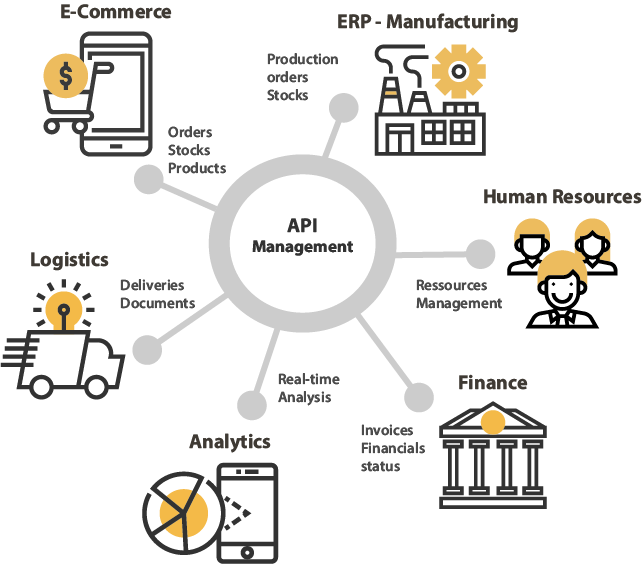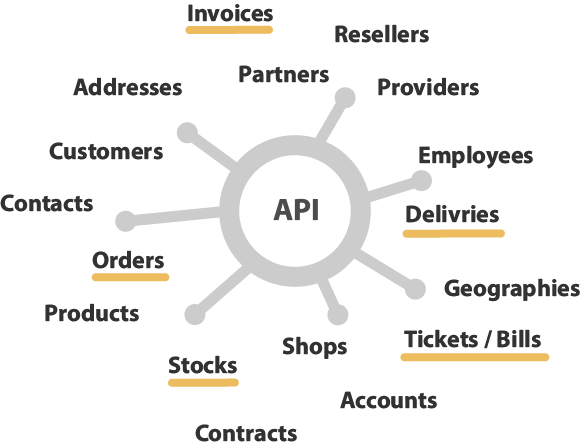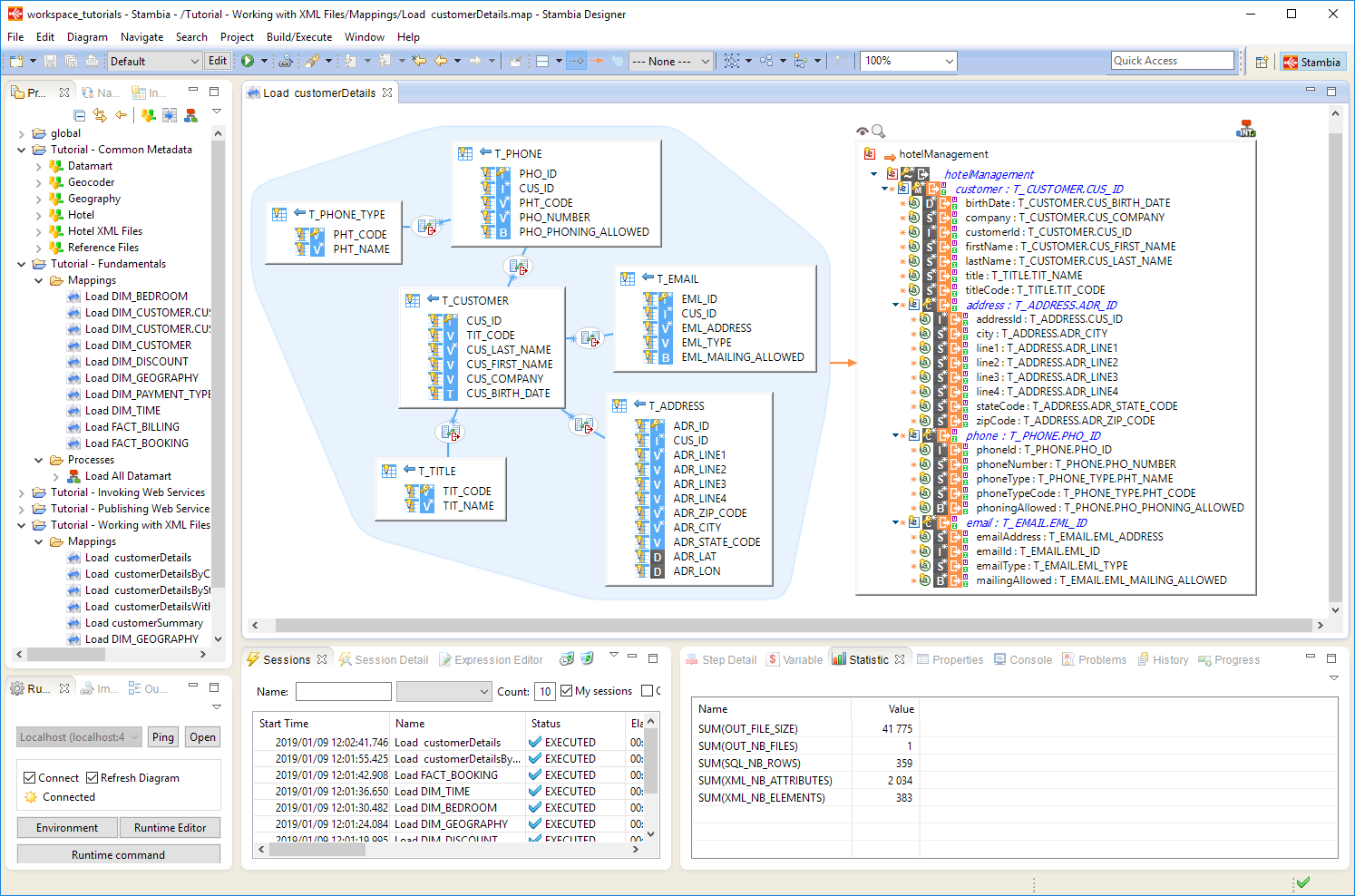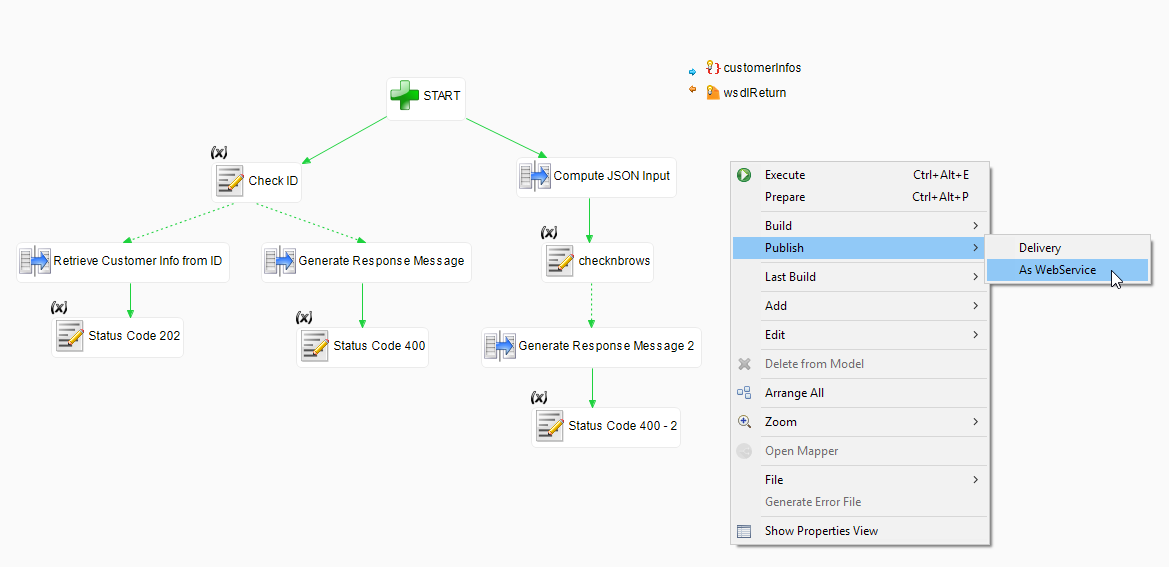 Stambia
The solution to all your data integrations needs
Stambia
The solution to all your data integrations needs

The Stambia API component
Discover how Stambia technology allows you to expose your data and processes without any line of code. Create complex services that aggregate data from multiple applications. "API-ze" your information system effortlessly and remain focused on "business" aspects and not technical issues.
Thanks to its unified solution and scalable technology, Stambia allows you to accelerate and industrialize the implementation of your API / Webservices / Microservices.

Use cases of the Stambia API component
As part of the ongoing digitisation process, organizations and it’s information systems are transforming rapidly. Every day, the digital ecosystem is enriched by new services and innovations so as to create value. But this comes with many challenges:
- How to quickly support new business data needs?
- How to connect / disconnect applications and new services (facilitate the plug'n' play mode of your Information System)?
- How to open the information system to its ecosystem (partners, customers, applications,...)?
To meet these challenges, a simple solution is to adopt an API approach. Discover the different possibilities offered by the Stambia API component.
Open the information system to the outside world
The digitisation and opening up of data makes it easier to collaborate and share information between companies, but it also increases the number of technologies and projects.
It is also necessary to be able to display or retrieve information from any system (both external and internal).
It is also important to make any internally managed data available in a flexible and agile manner.
Easily consume data available outside the IS
The democratization of Cloud and the rise of SaaS applications has enabled the development of standardized APIs, mostly in REST or SOAP mode.
In the context of a CRM project, for example, in the implementation of a SaaS solution (Salesforce, Microsoft Dynamics CRM,..), the use of APIs simplifies the implementation of a 360° customer vision.


Self-service Data
Data is now one of the main assets of organizations. The opening of company data to its ecosystem:
- optimizes exchanges with partners
- allows new services to be offered
- provides greater responsiveness and the ability to innovate more quickly
- contributes to the decompartmentalization of the information system
Data protection is also becoming essential for companies. The "API-zation" approach of the Information System also guarantees the implementation of good practices in terms of data security. This type of architecture, for example, is generally associated with the implementation of regulatory frameworks such as the GDPR.
Streamline the use of data

Business projects increasingly require associated data and processing. Information systems are built by accumulating different applications in silos. As a result, data is scattered and duplicated in multiple systems.
The implementation of a mutualization of data and processes by API allows to :
- Have fresh data (limit concerns related to data propagation)
- Responding to real-time issues
- Avoid the multiplication of the same data
- Promote the reuse of data
The Stambia component for APIs simplifies and speeds up the "API-zation" process. With a few clicks, it is possible to define a single entry point for the main categories of data (product, price, stock, customer, etc.).
Coupled with the Data Hub architecture, Stambia API is the ideal combination for the development of Web services / APIs for the information system.
Add agility to your information system
The Stambia component for API is the ideal solution to
- Implement a real-time data strategy
- Switch to an API-First strategy
- Create a level of abstraction through the use of micro services
- Innovate more quickly by facilitating experimentation
Indeed, it will make it possible in a concrete way to:
- Foster innovation by allowing partners (start-ups, suppliers, etc.) to interconnect easily and quickly with the company's information system (IS)
- Foster innovation by allowing partners (start-ups, suppliers, etc.) to interconnect easily and quickly with the company's information system (IS)
- Increase agility and accelerate the availability of centralized, open and secure data
For example, in the Retail sector: the implementation of an omnichannel strategy requires the provision of the most up-to-date data possible. The APIs developed with Stambia will make it possible to meet this challenge.
"API-ze" its traditional Legacy information system
Why adopt an "API-zation" approach to its traditional information system called "Legacy"?
Changing a brick like an ERP, a WMS system is a long, expensive and sometimes low value-added process. Nevertheless, the opening of the entire IS to the outside world has become essential.
Historical applications" can cause the Information System to become rigid:
- Owner / paid aspect of connectors
- Monolithic side
- Slow and complex developments
- Technological obsolescence with complexity or even inability to integrate technological developments
Using Web services / API allows you to overcome these constraints and discover new advantages:
- Reduce technical debt
- Relieve an infrastructure that is not scalable (in particular by implementing a Data Hub architecture)
How does the Stambia API component work?
The Stambia API component simplifies API/web management in integration projects, providing a high level of performance and disconcerting ease of development.
With the same agility as the other Stambia components, the API component can be used without any development effort (fully graphical approach). It offers a high level of productivity thanks to its Modeling approach and the use of native standards for all types of Web services (SOAP / HTTP REST protocol, XML and JSON input/output format).
Meeting the needs given by APIs to the business is no longer a complex and tedious task to deploy. Thanks to its technology, Stambia allows in a few clicks to build and make available Web services and API projects.
Find out how to deploy APIs: "as easy as child's play"!
API Development Studio
Integrated into the data integration solution without any specificity, API development with Stambia offers many advantages:
- Maintain the same logic as a standard development (data integration flow):
- No learning curve required
- Design of a Web service / API visually provided via Stambia Designer (WYSIWIG mode): no line of code to write
- Stay focused on business and non-technical aspects
- Take advantage of connectivity to all systems:
- SGBD : Oracle, PostgreSQL, MSSQL, ...
- NoSQL : MongoDB, ElasticSearch, ...
- Big Data : Hadoop, Spark, ...
- Cloud : Amazon AWS, Azure, Google Cloud Platform
- ERP, SAAS : Salesforce, SAP, ...
- Interact with other Web services / APIs
- Simply expose any data model in CRUD mode: add, modify or delete
- Supervise executions with the Production Analytics supervision console
- Ensure debugging from the Designer
Data Integration as a Service
Stambia allows the one-click publication of any data integration flow development as a Web service / API. This provides SOAP and REST HTTP access to a standard entry point (via HTTP). For API mode (HTTP REST), the management of return codes (200, 500) is native.
Therefore, any development done with Stambia can be seen as a service. The composition of services becomes easy, as does the implementation of a "Self-Service Data Integration" portal.
Integration with any existing API initiative
Stambia has native invocation and publishing capabilities for Web services / API. It supports SOAP (referred to as Web service) and HTTP REST (often referred to as API) protocols.
A wizard facilitates reverse engineering of any type of Web service / API. Authentication specificities such as Oauth2 are supported. In addition, Stambia API facilitates the management of standard input/output formats associated with Web services / APIs: XML, JSON.
Finally, Stambia interprets the WSDL, WSI description formats natively. But it also provides an entry point for describing Web services / APIs published on the Runtime (WSDL, WSI, Swagger 2.0 (S19.1)).
Integrate into API Management with ease
Stambia allows you to integrate natively into any API Management application.
The services published by Stambia comply with the Swagger or WSDL standards.
Integration with an API Management solution will enable:
- Defining overall security
- Setting up load balancing
- Managing the cache
- Administering and deploying services
- Monitoring statistics and performance
- Having a single point of administration and documentation
This is how development is accelerated thanks to the Stambia development studio and API Management’s simplified administration.
Watch our video to learn more about API Management with Stambia:

Performance management

Stambia does not require the implementation of a heavy and dedicated infrastructure. The Runtime, the real orchestration engine of the delegation in Stambia's ELT architecture, is a lightweight and easy to install component. Its duplication is as easy as a copy/paste. All this contributes to and encourages the industrialization of deployments.
From simple data integration to APIUsers of traditional data integration flows (batch, streaming, etc.) can respond quickly to an API / Web services initiative.
Thanks to its lightweight and simple design, Stambia API does not require any additional installation. A configuration is sufficient to activate the Runtimes already installed and to deploy the new services.
This flexibility reduces time-to-market and increases the success of business projects.
Need scalability?The Stambia Runtime can be deployed in Cluster mode to manage Failover. True to its Transformation Delegation Logic (ELT), it can be effortlessly integrated into a load balancing system. Stambia can be easily combined with load balancing systems such as Apache, F5, Juniper, Fortinet, Riverbed,...

Finally, due to its architecture, it can easily be deployed in an application container infrastructure (e. g. Docker) and delegate load management to a container orchestration platform such as Kubernetes to integrate with cloud architectures such as Google Cloud Platform / GCP, Amazon or Azure.
Technical specifications and prerequisites
| Specifications | Description |
|---|---|
|
Protocol |
HTTP REST / SOAP |
|
Output format |
XML, JSON + any specific format |
| Connectivity |
For more information, consult the technical documentation |
|
Description |
|
|
Execution |
|
| Stambia Version | From Stambia Designer s18.2.0 |
| Stambia Runtime version | From Stambia Runtime S17.3.0 |
| Notes |
|
Want to know more ?
Consult our resources
Did not find what you want on this page?
Check out our other resources:
Semarchy has acquired Stambia
Stambia becomes Semarchy xDI Data Integration




